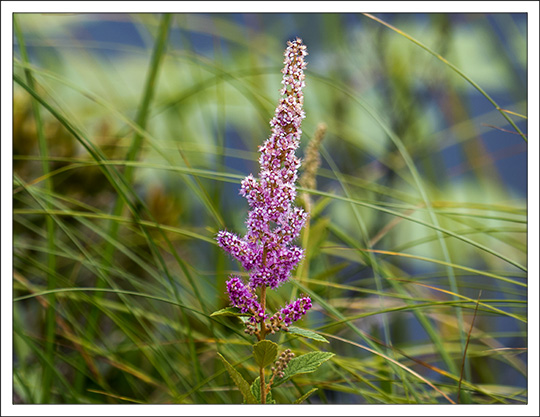Adirondack Shrubs:
Steeplebush (Spiraea tomentosa)
 Adirondack Shrubs: Steeplebush (Spiraea tomentosa) on the Heron Marsh Trail (24 July 2013)
Adirondack Shrubs: Steeplebush (Spiraea tomentosa) on the Heron Marsh Trail (24 July 2013)
| This page is no longer being updated. For an updated and expanded version of this material, see: Steeplebush (Spiraea tomentosa). |
Steeplebush (Spiraea tomentosa) is a native deciduous shrub which produces spike-like clusters of deep pink flowers in summer. This plant forms a mound-shaped thicket of slender, unbranched stems, three tor four feet tall. The pink to rose-purple flowers have five petals; they are about 1/4 inch wide and form a three to four inch cluster . The flowers are hermaphrodite (have both male and female organs). The plant generally blooms from July to September. Butterflies and other nectar-feeding insects find the flowers highly attractive. The flowers are followed by small, dry, brown fruit. The leaves are generally oval, about 2.5 inches long and one inch wide. The upper leaf surface is dark green; the lower surface is covered with dense woolly hairs. The bark is papery.
Steeplebush is a member of the Rose Family (Rosaceae). The genus name -- Spiraea -- comes from an ancient Greek word,meaning a spiraled or twisted wreath. It refers to the twisted seed pod of some of these species. The species name -- tomentosa -- means densely woolly. The plant is also known as Hardhack and Hardhack Spiraea. The common name -- Steeplebush -- is a reference to the steeple-like clusters of rose-pink flowers which appear in summer.
A similar species, Meadowsweet, does not have woolly twigs or hair on the undersides of the leaves. Another similar species, Japanese Spiraea (S. japonica) is a nonnative invasive plant; it has flat-topped clusters of pink flowers.
Steeplebush has been used by native Americans for medicinal purposes. The Algonquin reportedly used an infusion of leaves and stems as a medicinal tea. The Mohegans are said to have used an infusion of leaves to treat dysentery. The Ojibwa used and infusion of leaves and flowers for sickness in pregnancy and for easing childbirth.
Steeplebush grows in sunny or slightly shady areas in swamps and open moist ground at the Paul Smiths VIC and other locations in the Adirondack Mountains and upstate New York. It prefers wet, moderately acid soils. The plant can be found in the eastern half of the US and Canada, including New York State. It appears from Ontario and Quebec south to Georgia and Mississippi.
At the Paul Smiths VIC, Steeplebush may be seen along the margins of Heron Marsh, from the Heron Marsh Trail, Woods and Waters Trail, Bobcat Trail, and Logger's Loop Trail. It may also be seen on the shorelines of Black Pond (from the Black Pond Trail) and Long Pond (from the Long Pond Trail). Steeplebush usually blooms in this part of the Adirondack Park in July, depending on the weather.
References
- Lady Bird Johnson Wildflower Center. Native Plant Database.
- United States Department of Agriculture. Plants Database.
- University of Michigan. Native American Ethnobotany. A Database of Foods, Drugs, Dyes and Fibers of Native American Peoples, Derived from Plants.
- NatureServe Explorer. Online Encyclopedia of Life.
- Plants for a Future. Database.
- University of Wisconsin. Robert W. Freckmann Herbarium.
- University of Wisconsin. Shrubs of Wisconsin.
- Connecticut Wildflowers. Wildflower Guide.
- New York Flora Association. New York Flora Atlas.
- ENature. Wildflower Field Guide.
- Minnesota Wildflowers. Database.
- Doug Ladd. North Woods Wildflowers (Falcon Publishing, 2001), p. 99.
- Lawrence Newcomb. Newcomb's Wildflower Guide (Little Brown and Company, 1977), pp. 310-311.
- Roger Tory Peterson and Margaret McKenny. A Field Guide to Wildflowers. Northeastern and North-central North America (Houghton Mifflin Company, 1968) pp. 224-225, 284-285.
- National Audubon Society. Field Guide to Wildflowers. Eastern Region. (Alfred A. Knopf, 2001), p. 761.
- William K. Chapman, et al. Wildflowers of New York in Color (Syracuse University Press, 1998), pp. 54-55.
- William K. Chapman and Alan E. Bessette. Trees and Shrubs of the Adirondacks: A Field Guide (North Country Books, 1990), p. 49, Plate 17.
- Anne McGrath. Wildflowers of the Adirondacks (EarthWords, 1981, 2000), p. 68, Plate 17.
- Steven Clemants and Carol Gracie. Wildflowers in the Field and Forest: A Field Guide to the Northeastern United States (Oxford University Press, 2006), pp. 70-71.
- Meiyin Wu and Dennis Kalma. Wetland Plants of the Adirondacks. Ferns, Woody Plants, and Gramminoids(Trafford Publishing, 2010), p. 107.
- John Krichner and Gordon Morrison. A Field Guide to Eastern Forests (Houghton Mifflin Company, 1998), pp. 191, 326, 392-393.
